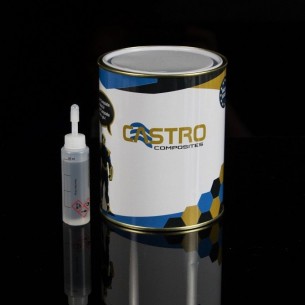Gel Coats / Top Coats
A gelcoat is a material, based on a modified thermosetting resin, used to provide a high-quality finish on the visible surface of a fibre-reinforced composite that is used on mould during any of the common composite processes: hand lay-up, infusion, RTM light, RTM classic, spray-up, etc.
A topcoat is a gelcoat that has been modified with paraffin in order the get rid off the tacky finish typical from the polyester or vinyl ester gel coats and is used as a final coat, normally at the back of a composite part. Epoxy topcoats have no paraffin and are just considered as paints.
The most common gelcoats are based on unsaturated polyester, vinyl ester or epoxy resin chemistry. At Castro Composites we offer a really wide range of gelcoats of all types and colors. Gelcoats are modified resins which are applied to moulds in the liquid state. They are cured to form crosslinked polymers and are subsequently backed with composite polymer matrices, often mixtures of resin and fibres.
The manufactured component, when sufficiently cured and removed from the mould, presents the gelcoated surface. This is usually a coloured, glossy surface which improves the aesthetic appearance of the part, such as a bath tube, a boat hull or deck, a wind blade, a car body panel, etc.
Many marine craft and aircraft are manufactured using composite materials with an outer layer of gelcoat, typically 0.5 mm to 0.8 mm (0.02 in to 0.03 in) thick. Gelcoats are designed to be durable, providing resistance to ultraviolet degradation and hydrolysis.
Specialized gelcoats can be used for tooling manufacture which in turn are used to manufacture parts. These require very high levels of durability to overcome the mechanical and thermal stresses encountered during the curing and demoulding processes.
In addition to any pigment a gelcoat will, if necessary, contain a thixotropic additive to assist its tenacity to vertical portions of the mould whilst it cures.
 Cookie preferences
Cookie preferences


 Español
Español Français
Français Deutsch
Deutsch Italiano
Italiano Português
Português


























